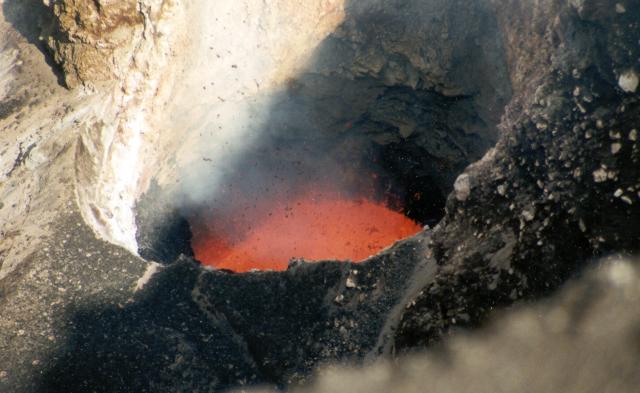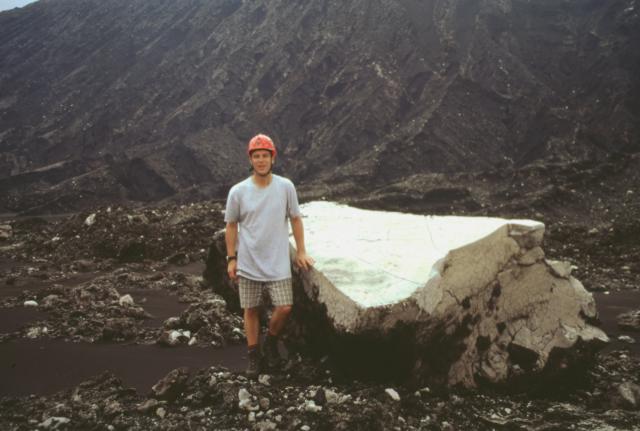Report on Ambrym (Vanuatu) — August 1999
Bulletin of the Global Volcanism Network, vol. 24, no. 8 (August 1999)
Managing Editor: Richard Wunderman.
Ambrym (Vanuatu) Lava lake activity and ash emission from both Benbow and Marum craters
Please cite this report as:
Global Volcanism Program, 1999. Report on Ambrym (Vanuatu) (Wunderman, R., ed.). Bulletin of the Global Volcanism Network, 24:8. Smithsonian Institution. https://doi.org/10.5479/si.GVP.BGVN199908-257040
Ambrym
Vanuatu
16.25°S, 168.12°E; summit elev. 1334 m
All times are local (unless otherwise noted)
Observations within Ambrym's summit crater were made by John Seach during a 22-30 August 1999 climb. There are two active cones in the caldera complex, Benbow and Marum. The Marum cone has three active sub-craters: Mbwelesu, the main crater; Niri Mbwelesu, a secondary crater close to Mbwelesu's rim; and Niri Mbwelesu Taten, a small collapse pit to the S of Niri Mbwelesu. Seach found increased activity compared to a previous visit in January 1999 (BGVN 24:02), with one new vent inside the Benbow crater and a second lava lake in Mbwelesu crater. Temperature measurements were made with a hand-held digital thermometer with an 8-cm probe. All depth estimates are visual; distances were estimated in comparison to a climbing rope.
A Mw 6.5 earthquake on 22 August was centered ~18.6 km NW of Ambrym volcano. Seach reported that the earthquake was felt with an intensity of MM VI with large ground movements in a NW-SE direction for 10 seconds. The earthquake caused landslides in the caldera and opened large cracks in the rim of Benbow crater. Coconut trees were knocked down on the W coast of Ambrym Island, and there was infrastructure damage in southern Pentecost Island. Fourteen aftershocks were felt during the next 8 hours.
Activity at Benbow. The crater was full of vapor when climbed on 22 August, but bubbling lava sounds were heard. A brown ash emission at 1740 was followed that night by moderate glow. Occasional crater explosions were heard between 1400 and 2100 on 26 August. Good visibility into the crater the next day showed that a new vent had opened on the N crater floor that was continually emitting light brown ash that rose 1,500 m above the crater floor (~2,300 m altitude) before being blown to the SE. Thicker ash emissions about every 5 minutes were accompanied by vigorous degassing; these emissions rose at a rate of ~13.5 m/s. From 1615 to 1625 on 27 August there were 66 discrete explosions or loud venting noises heard from the crater. At one location on the NW rim of the central crater, 200 m from the new vent, a recent ash deposit was ~50 m thick. Fumaroles were active on the inside N wall of the central crater, with yellow and red deposits at their bases. The lava lake vent that was covered by an avalanche in January had reopened and exhibited orange glow from the pit at night; white vapor tinged with blue was emitted, and brown ash was ejected every 15-30 minutes. Both active vents glowed a brilliant orange color at night. Loud degassing was heard at 0620 on 28 August from a distance of 4 km.
Activity at Mbwelesu. Excellent visibility at times during 26-28 August allowed detailed observations of the crater bottom. Continuous load roaring and crashing sounds were heard coming from the pit. Explosions shook the ground and bombs could be heard striking inside the crater. An observer on the E edge of the crater, 350 m from the lava, felt radiant heat. Scattered blocks 20-30 cm in diameter and Pele's hair covered the edge of the crater. A fumarole field 60 m SE of the crater had a measured temperature of 53°C. A brown pond was present on the floor of the Marum crater. The central floor of the 1953 crater (in Marum adjacent to Mbwelesu) contained a green pond surrounded by active fumaroles. Intense night glow was visible on the evening of 26 August.
Three vents were active within the Mbwelesu crater. Vent A, in the SE part of the crater, was ~10 m wide and ejected sprays of lava 150 m high every 5-10 seconds. Occasional lava spatter fell onto the vent wall. Lava spray was generally directed S, and formed black marks on the wall of Mbwelesu crater.
Vent B, in the central part of the crater, was roughly circular and ~45 m in diameter. It was ~15 m from the rim to the lava lake. During this visit the lava lake exhibited 20-m-high waves moving across the pit. Vigorous boiling of the surface and incandescent lava fountaining to 150 m heights was observed. Some black bombs were ejected. At 1220 on 28 August a large part of the S rim of the pit fell into the lava lake, generating a large brown cloud that filled Mbwelesu crater and triggering Strombolian explosions for the next 10 minutes.
Vent C within the Mbwelesu crater (figure 4) was located NW of Vent B. When seen in January 1999 this vent emitted burning gas, but it had deepened, widened, and contained a lava lake by 28 August. The elongate ~75 x 45 m pit had a steep N wall (~75 m high), but was open to the S (rim ~15 m above the lava lake). The lava lake surface was directly visible and boiling violently, ejecting showers of dark bombs every 1-2 seconds. Lava fountaining occurred from a fixed point along the edge from the NE to the E side of the pit. Some bombs remained incandescent for 20 seconds in the daylight. Lava was splashing onto the SW walls and sides of the pit after emerging from the NW edge of the lake. Horizontal current flow was estimated at 8 m/s towards the SE shore across at least 75% of the diameter of the lake. Three simultaneous 20-m-diameter lava bubbles were seen that almost filled the entire lake surface.
 |
Figure 4. Photograph of Vent C in the Mbwelesu Crater at Ambrym, 28 August 1999. Courtesy of John Seach. |
Activity at Niri Mbwelesu. White sulfurous-smelling gas was emitted from the pit in late August. Mild degassing was observed from the south part of the crater, and fumaroles were active on the N crater wall.
Activity at Niri Mbwelesu Taten. Compared to January 1999, in late August there was an increase in activity and substantial morphological changes. On 25 August at 1045 a thick brown ash emission continued for 5 minutes, rising 300 m and then being carried 4 km NW by the wind. Similar ash emissions occurred at 10-20 minute intervals during the afternoon. The E rim was littered with new rocks. Recent cowpat bombs were present 10-20 m from the E side of the crater. Mild degassing and sloshing lava sounds were heard. Fumaroles were active in two small collapse pits on the SE side of the crater. The fumarole field 40 m SE of the main pit had a temperature measured at 67-69°C, the same as in January 1999. Views into the crater to a depth of 150 m were obtained on 28 August, but the bottom was not seen. The south inside wall was covered with yellow deposits. Red-brown ash was building a raised rim on the NW side of the pit. The pit was degassing every 1-2 seconds. Fumaroles on a sill 50 m down were venting in unison with the main pit. Bubbles of hot gas 20 m in diameter were observed rising from the vent at 30 m/s.
 |
Figure 5. Lithic block ejected 100 m NE of the Niri Mbwelesu Taten collapse pit at Ambrym, August 1999. Courtesy of John Seach. |
Geological Summary. Ambrym, a large basaltic volcano with a 12-km-wide caldera, is one of the most active volcanoes of the New Hebrides Arc. A thick, almost exclusively pyroclastic sequence, initially dacitic then basaltic, overlies lava flows of a pre-caldera shield volcano. The caldera was formed during a major Plinian eruption with dacitic pyroclastic flows about 1,900 years ago. Post-caldera eruptions, primarily from Marum and Benbow cones, have partially filled the caldera floor and produced lava flows that ponded on the floor or overflowed through gaps in the caldera rim. Post-caldera eruptions have also formed a series of scoria cones and maars along a fissure system oriented ENE-WSW. Eruptions have apparently occurred almost yearly during historical time from cones within the caldera or from flank vents. However, from 1850 to 1950, reporting was mostly limited to extra-caldera eruptions that would have affected local populations.
Information Contacts: John Seach, P.O. Box 16, Chatsworth Island, NSW 2469, Australia.

